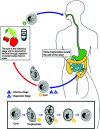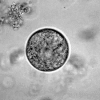Current world status of Balantidium coli
- PMID: 18854484
- PMCID: PMC2570149
- DOI: 10.1128/CMR.00021-08
Current world status of Balantidium coli
Abstract
Balantidium coli is a cosmopolitan parasitic-opportunistic pathogen that can be found throughout the world. Pigs are its reservoir hosts, and humans become infected through direct or indirect contact with pigs. In rural areas and in some developing countries where pig and human fecal matter contaminates the water supply, there is a greater likelihood that balantidiosis may develop in humans. The infection may be subclinical in humans, as it mostly is in pigs, or may develop as a fulminant infection with bloody and mucus-containing diarrhea; this can lead to perforation of the colon. The disease responds to treatment with tetracycline or metronidazole. Balantidiosis is a disease that need never exist given access to clean water and a public health infrastructure that monitors the water supply and tracks infections. Its spread can be limited by sanitary measures and personal hygiene, but it is a disease that will be around as long as there are pigs. Immunocompromised individuals have developed balantidiosis without any direct contact with pigs, perhaps with rats or contaminated produce as a possible source of infection. For the clinician, balanatidiosis should be included in the differential diagnosis for persistent diarrhea in travelers to or from Southeast Asia, the Western Pacific islands, rural South America, or communities where close contact with domestic swine occurs. Warming of the earth's surface may provide a more favorable environment, even in the now-temperate areas of the world, for survival of trophic and cystic stages of Balantidium, and its prevalence may increase. Effective sanitation and uncontaminated water are the most useful weapons against infection. Fortunately, balantidiosis responds to antimicrobial therapy, and there have been no reports of resistance to the drugs of choice.
Figures




References
-
- Adl, S. M., A. G. B. Simpson, M. A. Farmer, R. A. Andersen, O. R. Anderson, J. R. Barta, S. S. Bowser, G. Brugerolle, R. A. Fensome, S. Fredericq, T. Y. James, S. Karpov, P. Kugrens, J. Krug, C. E. Lewis, J. Lodge, D. H. Lynn, D. G. Mann, R. M. McCourt, L. Mendoza, O. Møestrup, S. E. Mozley-Standridge, T. A. Nerad, C. A. Shearer, A. V. Smirnov, F. W. Spiegel, and M. F. J. R. Taylor. 2005. The new higher level classification of eukaryotes with emphasis on the taxonomy of protists. J. Eukaryot. Microbiol. 52:399-451. - PubMed
-
- Anargyrou, K., G. L. Petrikkos, M. T. E. Suller, A. Skiada, M. R. Siakantaris, R. T. Osuntoyinbo, G. Pangalis, and G. Vaiopoulos. 2003. Pulmonary Balantidium coli infection in a leukemic patient. Am. J. Hematol. 73:180-183. - PubMed
-
- Baker, J. R. 1973. Parasitic protozoa. Hutchinson University Library, London, United Kingdom.
-
- Barnish, G., and R. W. Ashford. 1989. Occasional parasitic infections of man in Papua New Guinea and Irian Jaya (New Guinea). Ann. Trop. Med. Parasitol. 83:121-135. - PubMed
Publication types
MeSH terms
Substances
LinkOut - more resources
Full Text Sources
Other Literature Sources

